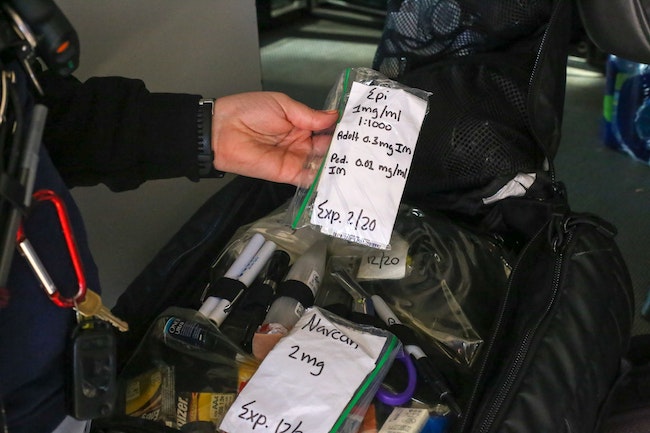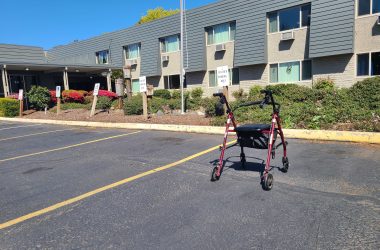
A look inside the black bag that CAHOOTS crisis workers carry to 911 calls. It contains Narcan, as well as wound cleaner, medicine for allergic reactions and more. (Troy Brynelson/Salem Reporter)
As Salem begins putting together its budget, city residents have a clear request: fund a crisis response team.
City leaders have previously voiced support for a local program modeled after Eugene’s CAHOOTS, where a crisis worker and EMT respond to low-level 911 calls for people having mental health crises, rather than police. But there’s no funding for such a program in the draft city budget City Manager Steve Powers presented Wednesday to the city council.
During Wednesday’s Budget Committee Meeting, a couple people testified in support over Zoom, and another 81 wrote in favor of allocating money toward such a program in public testimony. One man even wrote a poem.
“Mobile response units not only save lives, they save money and resources by handling non-emergent medical issues, avoiding costly transport and aids. We need to add this unit to our public safety resources. There is a deeper need more now than ever,” Danielle Howden wrote to the committee.
“A mobile crisis response team is necessary to provide accessibility to those with disabilities and mental illness,” wrote Tina Noon.
Most of the meeting was spent discussing how the city could use $32.9 million in incoming federal funds from the American Rescue Plan Act, federal Covid relief money passed by Congress in March. It is one of several budget meetings before a final budget goes before the Salem City Council for approval in June.
City Manager Steve Powers presented his proposed $657.5 budget to councilors and committee members, saying the one-time federal funds would be used for revenue replacement and for Covid expenses.
That includes $11.3 for the general fund, $500,000 to replace lost revenue from downtown parking and $3.2 million for the cultural and tourism fund.
Another $8.1 million is to be set aside for future programs and investments, according to the budget presentation.
Councilor Vanessa Nordyke, who has been a vocal proponent of a mobile response unit, said some of that money could be bookmarked for a CAHOOTS-style program locally.
The city’s chief financial officer, Robert Baron, said the city is waiting to receive more guidance from the U.S. Treasury about how they can use that $8.1 million.
“We can’t advise council until we get specific guidance ourselves,” he said.
Other committee members cautioned against allocating the one-time funds for an ongoing project, because the federal money has to be spent by 2024. After that, the city would be tasked with finding another funding source for a mobile response unit.
Nordyke told Salem Reporter if the federal dollars can’t be used for that purpose, she will work with staff to explore other funding options, like general fund money.
According to a proposed estimate from the Mid-Willamette Valley Community Action Agency and United Way of the Mid-Willamette Valley, a mobile response unit would cost about $440,000 a year.
Councilor Jose Gonzalez said he’s in support of a response unit and that many of the calls would be in the northeast Salem ward he represents.
He said his brother, who has a business off Interstate 5, has daily interactions with people in mental health crisis.
“It’s the same with a lot of other people I know,” Gonzalez said.
He said in general everyone wants the program, but need to figure out how it will work logistically.
Powers focused on one of six priority areas for the city during Wednesday’s meeting, “welcoming and livable community.” There are budget meetings each Wednesday evening until at least May 6 to go over other priorities.
The Welcoming and Livable Community category has a $46.4 million budget that includes parks and recreation, neighborhood enhancement, code compliance, planning, library, cultural and tourism grants, public art, housing and social service grants, among others.
Powers said the city’s Homeless Rental Assistance Program, which provides a year of rental assistance and intensive case management for those who are chronically homeless will be funded at $560,000.
That money is half of what was allocated for HRAP last year. Powers said that reflects “program limitations” including extensive case management needs and a low rental inventory. The Salem Housing Authority has had difficulty getting landlords to sign onto the program during the statewide eviction moratorium.
Powers also highlighted $300,000 of general fund money going to restoring areas at Wallace Marine Park and Cascades Gateway Park, where unsheltered people have been allowed to camp for the last year because of Covid.
After the Salem-Keizer School District ended a $623,000 contract for school resource officer program, the city will have to use $1 million in general fund dollars to pay for officers who have been reassigned to other tasks, the budget shows.
Contact reporter Saphara Harrell at 503-549-6250, [email protected].
BE PART OF OUR TEAM FOR SALEM’S BENEFIT: Accurate local information is vital for any community and that’s harder to come by in this day of “anyone can post anything” to social media. People in communities without trained journalists working for them don’t have accurate, trusted information. Help Salem avoid that fate – join in putting fuel in the tank of Salem Reporter to keep it growing, going strong. Here’s how:
SUBSCRIBE: A monthly digital subscription starts at $5 a month.
GIFT: Give someone you know a subscription.
ONE-TIME PAYMENT: Contribute any amount and you support giving the people of Salem local news otherwise missing. (You can also mail your contribution: Salem Reporter, 72585 Middle Fork Lane, Bates OR 97817)









